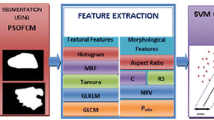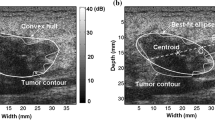Abstract
This study presents a computer-aided diagnosis (CAD) system with textural features for classifying benign and malignant breast tumors on medical ultrasound systems. A series of pathologically proven breast tumors were evaluated using the support vector machine (SVM) in the differential diagnosis of breast tumors. The proposed CAD system utilized facile textural features, i.e., block difference of inverse probabilities, block variation of local correlation coefficients and auto-covariance matrix, to identify breast tumor. An SVM classifier using the textual features classified the tumor as benign or malignant. The proposed system identifies breast tumors with a comparatively high accuracy. This can help inexperienced physicians avoid misdiagnosis. The main advantage of the proposed system is that the training and diagnosis procedure of SVM are faster and more stable than that of multilayer perception neural networks. With the expansion of the database, new cases can easily be gathered and used as references. This study dramatically reduces the training and diagnosis time. The SVM is a reliable choice for the proposed CAD system because it is fast and excellent in ultrasound image classification.






Similar content being viewed by others
References
American Cancer Society (2003) Breast cancer facts and figures 2001–2002. American Cancer Society, Atlanta, Georgia
Stavros AT, Thickman D, Rapp CL, Dennis MA, Parker SH, Sisney GA (1995) Solid breast nodules: use of sonography to distinguish between benign and malignant lesions. Radiology 196(1):123–134
Bassett LW, Liu TH, Giuliano AE, Gold RH (1991) The prevalence of carcinoma in palpable vs impalpable, mammographically detected lesions. AJR Am J Roentgenol 157(1):21–24
Chen D, Chang RF, Huang YL (2000) Breast cancer diagnosis using self-organizing map for sonography. Ultrasound Med Biol 26(3):405–411
Chen DR, Chang RF, Huang YL, Chou YH, Tiu CM, Tsai PP (2000) Texture analysis of breast tumors on sonograms. Semin Ultrasound CT MR 21(4):308–316
Chen DR, Chang RF, Kuo WJ, Chen MC, Huang YL (2002) Diagnosis of breast tumors with sonographic texture analysis using wavelet transform and neural networks. Ultrasound Med Biol 28(10):1301–1310
Chen DR, Chang RF, Huang YL (1999) Computer-aided diagnosis applied to US of solid breast nodules by using neural networks. Radiology 213(2):407–412
Garra BS, Krasner BH, Horii SC, Ascher S, Mun SK, Zeman RK (1993) Improving the distinction between benign and malignant breast-lesions—the value of sonographic texture analysis. Ultrason Imaging 15(4):267–285
Haykin S (1999) Multilayer perceptrons. In: Marcia Horton (ed) Neural networks: a comprehensive foundation, 2nd edn. Prentice-Hall, New Jersey, pp. 156–255
Yang DC, Sang YS (2003) Image retrieval using BDIP and BVLC moments. IEEE Trans Circuits Syst Video Technol 13(9):951–957
Christianini N, Shawe-Taylor J (2000) An introduction to support vector machines and other kernel-based learning methods. Cambridge University Press, UK
Kim KI, Jung K, Park SH, Kim HJ (2002) Support vector machines for texture classification. IEEE Trans Pattern Anal Mach Intell 24(11):1542–1550
Song Q, Hu WJ, Xie WF (2002) Robust support vector machine with bullet hole image classification. IEEE Trans Syst Man Cyber C Appl Rev 32(4):440–448
El Naqa I, Yang YY, Wernick MN, Galatsanos NP, Nishikawa RM (2002) A support vector machine approach for detection of microcalcifications. IEEE Trans Med Imaging 21(12):1552–1563
Yang MH, Roth D, Ahuja N (2002) A tale of two classifiers: SNoW vs. SVM in visual recognition. Comput Vis—ECCV 2353(Pt IV):685–699
Sun YF, Fan XD, Li YD (2003) Identifying splicing sites in eukaryotic RNA: support vector machine approach. Comput Biol Med 33(1):17–29
Song MH, Breneman CM, Bi JB, Sukumar N, Bennett KP, Cramer S et al (2002) Prediction of protein retention times in anion-exchange chromatography systems using support vector regression. J Chem Inf Comput Sci 42(6):1347–1357
Hanley JA, McNeil BJ (1982) The meaning and use of the area under a receiver operating characteristic (ROC) curve. Radiology 143(1):29–36
Weiss SM, Kapouleas I (1989) An empirical comparison of pattern recognition, neural nets, and machine learning classification methods. Proceedings of the 11th international joint conference on artificial intelligence. Morgan Kaufmann, Detroit, pp. 234–237
Acknowledgment
This work was supported by the National Science Council, Taiwan, Republic of China, under Grant NSC 93-2213-E-029-014.
Author information
Authors and Affiliations
Corresponding author
Rights and permissions
About this article
Cite this article
Huang, YL., Wang, KL. & Chen, DR. Diagnosis of breast tumors with ultrasonic texture analysis using support vector machines. Neural Comput & Applic 15, 164–169 (2006). https://doi.org/10.1007/s00521-005-0019-5
Received:
Accepted:
Published:
Issue Date:
DOI: https://doi.org/10.1007/s00521-005-0019-5




